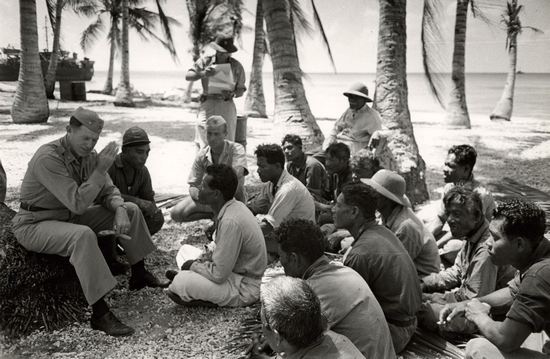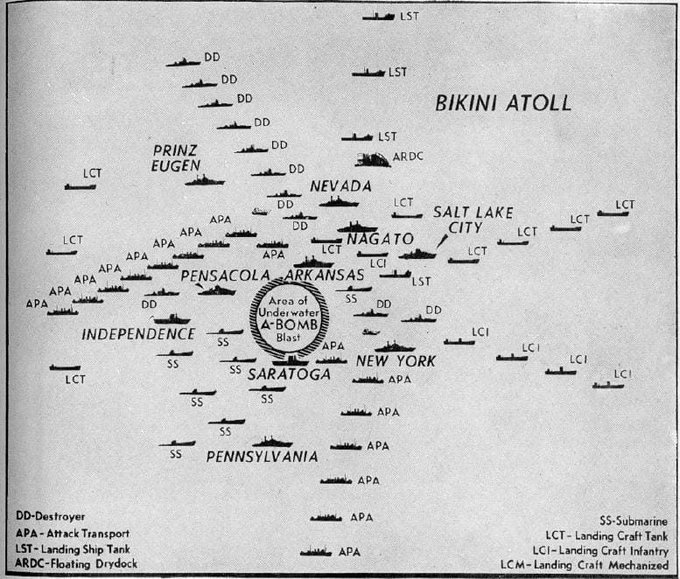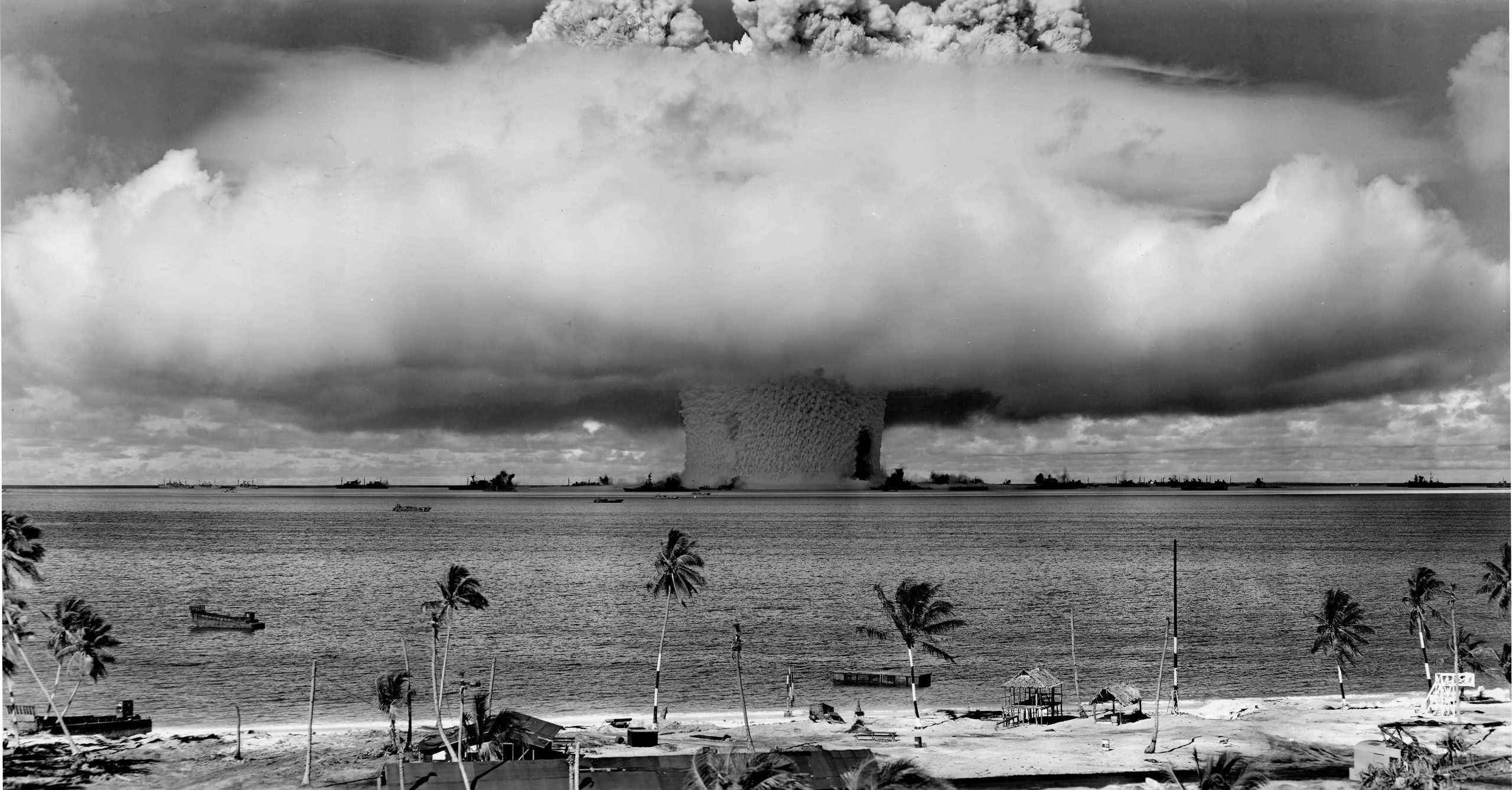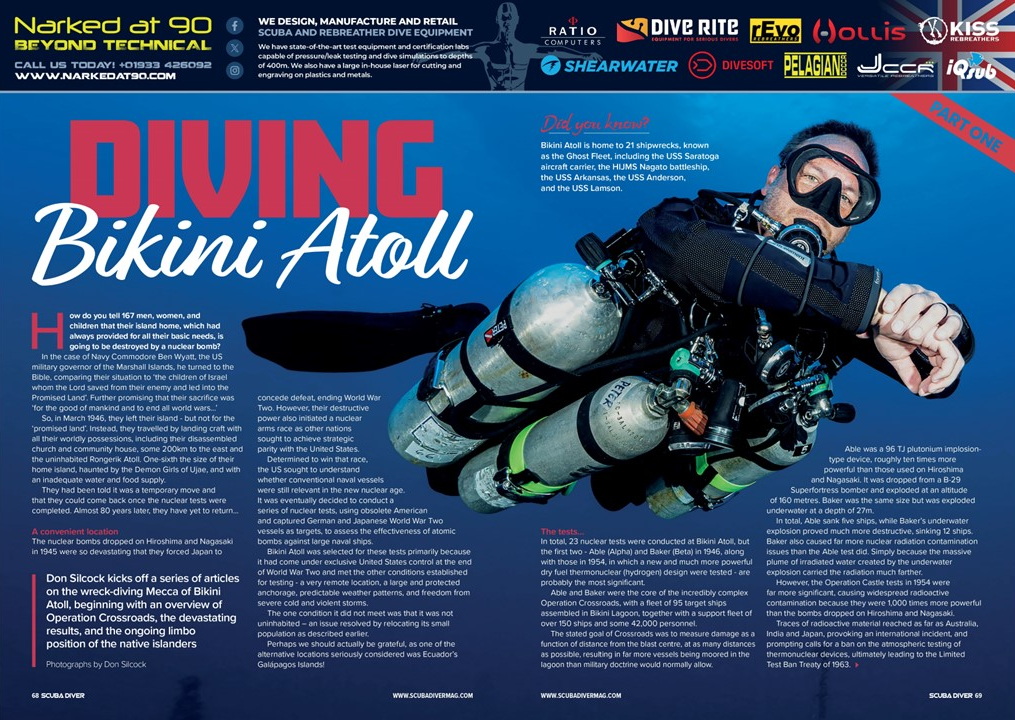
Diving Bikini Atoll… How do you tell 167 men, women, and children that their island home, which had always provided for all their basic needs, is going to be destroyed by a nuclear bomb?
In the case of Navy Commodore Ben Wyatt, the US military governor of the Marshall Islands, he turned to the Bible.
Comparing their situation to “the children of Israel whom the Lord saved from their enemy and led into the Promised Land.” Further promising that their sacrifice was “for the good of mankind and to end all world wars…”
So, in March 1946 they left their island – but not for the promised land. Instead, they traveled by landing craft some 200 km to the east, together with all their worldly possessions. Including their disassembled church and community house.
Their destination was Rongerik Atoll. An uninhabited coral atoll of 17 islands, just one-sixth the size of their home island.
Said to be haunted by the Demon Girls of Ujae and with an inadequate water and food supply. The Bikini Islanders were told it was a temporary move and that they could come back once the nuclear tests were completed. Almost 80 years later, they have yet to return…

Diving Bikini Atoll – A Convenient Location
 The nuclear bombs dropped on Hiroshima and Nagasaki in 1945 were so devastating they forced Japan to concede defeat, ending WWII. However, their destructive power also initiated a nuclear arms race. As other nations sought to achieve strategic parity with the United States.
The nuclear bombs dropped on Hiroshima and Nagasaki in 1945 were so devastating they forced Japan to concede defeat, ending WWII. However, their destructive power also initiated a nuclear arms race. As other nations sought to achieve strategic parity with the United States.
Determined to win that race, the US sought to understand whether conventional naval vessels were still relevant in the new nuclear age. It was eventually decided to conduct a series of nuclear tests. Using obsolete American and captured German and Japanese WWII vessels as targets. To assess the effectiveness of atomic bombs against large naval ships.
Bikini Atoll was selected for these tests primarily because it had come under exclusive United States control at the end of WWII. Plus it met the other conditions established for testing… A very remote location, a large and protected anchorage, predictable weather patterns, and freedom from severe cold and violent storms.
The one condition it did not meet was that it was not uninhabited – an issue resolved by relocating its small population to the “promised land.”
Perhaps we should actually be grateful, as one of the alternative locations seriously considered was Ecuador’s Galápagos Islands!
Diving Bikini Atoll – Operation Crossroads
In total, 23 nuclear tests were conducted at Bikini Atoll. But the first two – Able (Alpha) and Baker (Beta) in 1946, along with those in 1954, in which a new and much more powerful dry fuel thermonuclear (hydrogen) design were tested, are probably the most significant.

Able and Baker were the core of the incredibly complex Operation Crossroads. With a fleet of 95 target ships assembled in Bikini Lagoon, together with a support fleet of over 150 ships and some 42,000 personnel.
The stated goal of Crossroads was to measure damage as a function of distance from the blast center, at as many distances as possible. Resulting in far more vessels being moored in the lagoon than military doctrine would normally allow.
Able was a 96 TJ plutonium implosion-type device, roughly ten times more powerful than those used on Hiroshima and Nagasaki. It was dropped from a B-29 Superfortress bomber and exploded at an altitude of 160m. Baker was the same size but was exploded underwater at a depth of 27m.
In total, Able sank five ships, while Baker’s underwater explosion proved much more destructive, sinking 12 ships. Baker also caused far more nuclear radiation contamination issues than the Able test did.
Simply because the massive plume of irradiated water created by the underwater explosion carried the radiation much farther.
Diving Bikini Atoll – Operation Castle
However, the Operation Castle tests in 1954 were far more significant. Causing widespread radioactive contamination because they were 1000 times more powerful than the bombs dropped on Hiroshima and Nagasaki.
Traces of radioactive material reached as far as Australia, India, and Japan, provoking an international incident. Prompting calls for a ban on the atmospheric testing of thermonuclear devices. And ultimately leading to the Limited Test Ban Treaty of 1963.

Diving Bikini Atoll – The Backstory….
From a purely technical perspective, the stated goal of Operation Crossroads is understandable. But the backstory is less so… The size, strength, and capability of the United States Navy proved to be very significant in the overall Allied victory in WWII. However, there was real concern at the highest levels of its leadership that the Navy’s role as America’s “first line of defense” would be greatly diminished in the new nuclear age.
Those leaders were determined to demonstrate that large naval ships could withstand nuclear explosions. While the Air Force wanted the test to show the vulnerability of the ships.
The overall result of Operation Crossroads was that large naval ships were much more vulnerable to “dirty” underwater nuclear explosions than they were to “clean” ones in the air. Ships outside the blast “red zone” were hardly impacted. And eight of the major ships and two submarines were towed back to the United States and Hawaii for radiological inspection. Twelve target ships were so lightly contaminated that they were remanned and sailed back to the United States by their crews. The rest of the targets were ultimately scuttled off Bikini and Kwajalein Atolls.
The Shipwrecks
Out of all the wrecks at Bikini, seven are dived regularly. The aircraft carrier USS Saratoga, the Japanese battleship HIJMS Nagato, the battleship USS Arkansas, destroyers USS Anderson and USS Lamson, the submarines USS Apogon and USS Pilotfish and the transport vessel USS Carlisle.
All are in 50 to 55m depth and each one is truly an exceptional, almost once in a lifetime dive! But their depths mean that any dive on them requires careful planning and adherence to that plan. It’s real technical diving and its serious stuff.
Fascinating, exciting, adventurous but serious and I will cover that in the next article.

Where is Bikini Atoll?
Bikini Atoll is part of the Republic of the Marshall Islands (RMI). An isolated, sparsely populated, low-lying Pacific country consisting of more than 1,200 islands and islets covering just 180km2 of land, spread out over 2 million km2 of ocean.
Located just north of the equator in the central Pacific Ocean, roughly halfway between Papua New Guinea and Hawaii, the Marshall Islands were occupied by Japan during WWI. The United States drove the Japanese out during WWII and in 1947 they were made a Trust Territory of the Pacific Islands, administered by America.
They became an independent country in 1986 but signed a Compact of Free Association with the United States. Which means the USA remains responsible for defense, external security and providing financial assistance while retaining its military base and missile testing range on Kwajalein Atoll.
Getting There…

The journey to Bikini Atoll is an adventure in itself. And from Australia it starts with a flight to Hawaii to connect with the “island hopper” operated by United Airlines. Which for me meant a Qantas flight from Sydney and an overnight stay in Honolulu.
United are the sole option as they are the only airline that flies into the military base on Kwajalein Atoll. Entry into the base is not allowed and although you can land there, you are escorted from the small terminal to the jetty where the military operate a ferry to the nearby island of Ebeye. The base is the main employer and most of the employees live on Ebeye and “commute” on the ferry.
Ebeye is also where the Master Liveaboard’s Pacific Master is based. And their trips operate around the United Airline flights from and to Honolulu. Which is where the island hopper comes in… Because after Kwajalein the United flight continues on eastwards towards Guam. Before returning a day or sometimes two later.

How to Dive Bikini Atoll
There is only one option and that is the Pacific Master. Which operates at Bikini Atoll from May through to September with 10, 11 and 13 night itineraries.
Operating technical diving trips in such a remote location as Bikini Atoll involves some very significant logistical and operational challenges and Masters really do deserve congratulating for doing so. Particularly so after previous attempts at operating both a liveaboard and a land-based operation on Bikini ultimately failed.
Is It Safe?
Exactly the question my wife asked when I told her where I was going… Yes, is the answer, the wrecks themselves have been naturally cleansed over the nearly 80 years they have been there. And residual radiation is negligible.
Bikini itself is still not considered safe for long-term habitation due to radioactive pollution of groundwater and topsoil. So, nothing grown or living on the island can be consumed. Which is the reason the islanders have not been allowed to return.
Diving Bikini Atoll – In Summary
For me personally, diving Bikini Atoll was the (I thought…) the culmination of a two-year journey into technical diving. But it was such an epic and incredibly fascinating experience I am determined to go back and see more of this unique location.
Diving Bikini Atoll – Scuba Diver Article Part 1 of 3
Scuba Diver recently published the first of a series of three article on Diving Bikini Atoll. It’s a four-page article and you can download it using this link to Diving Bikini Atoll – Part 1.

